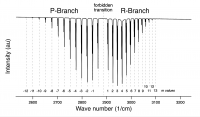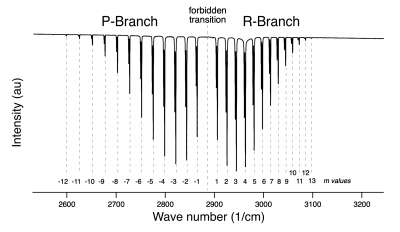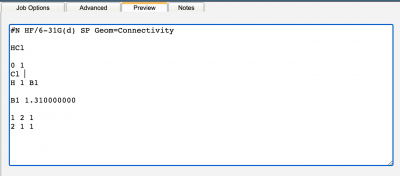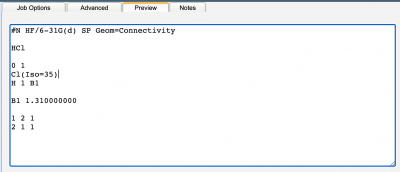Difference between revisions of "HCl Vibrational-Rotational Spectroscopy"
Jump to navigation
Jump to search
| (2 intermediate revisions by the same user not shown) | |||
| Line 75: | Line 75: | ||
::::conversion factor: 1.66054e-27 kg/amu | ::::conversion factor: 1.66054e-27 kg/amu | ||
| + | |||
| + | ===WebMO/Gaussian Calculation=== | ||
| + | WebMo/Gaussian calculation can be done to determine the B<sub>e</sub>, the rotational constant. It is usually required to specify the specific isotope for the atoms. This can be done by editing the input file (the z-matrix) within WebMO. | ||
| + | :- choose "preview", then "generate" when submitting your job... | ||
| + | :- add the text (Iso=35) or (Iso=37) after the Cl in the input file; for completeness add (Iso=1) after the H as well: | ||
| + | [[File:Screen Shot 2021-03-18 at 1.26.16 PM.png|400px]] | ||
| + | [[File:Screen Shot 2021-03-18 at 1.26.43 PM.png|400px]] | ||
===REPORTING=== | ===REPORTING=== | ||
Latest revision as of 18:40, 18 March 2021
(3/26/20, bes)
Adapted from Experiment #38 (Shoemaker, Garland, Nibler, 1989)
See Chapter 8 (Engel), more will be presented in lecture...
Sample Preparation
- a) Pull the HCl (g) off the headspace of a bottle of concentrated HCl using a 60 mL syringe.
- b) deliver the HCl (g) to the gas-sampling IR cell.
IR Gas-Phase Data Collection
- a) Collect data using the highest resolution.
- b) average 32 scans (both background and sample)
- c) Save-As...
- (A complete set of data can be found here.)
Spectral Analysis
- a) load IR data into Igor or Excel.
- b) Use the cursor tool to tabulate the H35Cl and H37Cl data into separate columns,
- c) Assign an "m-value" to each transition (note the 'm=0' forbidden transition) with the help of the following graphic (click to make bigger).
Data Analysis
Okay, so you should now have a table, probably in Excel but if you know how to do it in Igor then great (Igor does not offer any advantages here) with heading like this:
| m-value | H35Cl | H37Cl |
| -12 | XXXX | YYYY |
| -11 | XXXX | YYYY |
| -10 | XXXX | YYYY |
| -9 | XXXX | YYYY |
| ... | ... | ... |
| +1 | XXXX | YYYY |
| +12 | XXXX | YYYY |
| +13 | XXXX | YYYY |
- a) Make a plot, m-value verses freq (in 1/cm) for H35Cl data; this will NOT be a straight line but a polynomial curve.
- b) fit a second order polynomial to this data... ie y= ax2 + bx +c, and note the values for a, b, and c in your notes (lab notebook preferred).
- c) During our last lab period you were given a Shoemaker, et al. handout (???) that discussed this lab activity. Eq. 9 was:
ṽ = ṽo + (2Be - 2 αe) m - αe m2, which has the form y = c + bx + ax2
- a = αe
- b = 2Be - 2 αe
- so you can solve for Be (this is called the rotational constant and has units of 1/cm)...
- d) Now solve for the radius (r), the average internuclear separation of the H35Cl...
- e) repeat above for H37Cl.
Reduced mass calculations
- Reduced mass, μ = (m1*m2)/(m1+m2)
- 1H 1.007825 amu (99.9885%)
- 35Cl 34.968853 amu (75.78%)
- 37Cl 36.965903 amu (24.22%)
- conversion factor: 1.66054e-27 kg/amu
WebMO/Gaussian Calculation
WebMo/Gaussian calculation can be done to determine the Be, the rotational constant. It is usually required to specify the specific isotope for the atoms. This can be done by editing the input file (the z-matrix) within WebMO.
- - choose "preview", then "generate" when submitting your job...
- - add the text (Iso=35) or (Iso=37) after the Cl in the input file; for completeness add (Iso=1) after the H as well:
REPORTING
Please send email with the following information:
- H35Cl data
- ṽ0 =
- Be =
- μ (H35Cl) =
- r =
- H37Cl data
- ṽ0 =
- Be =
- μ (H37Cl) =
- r =




